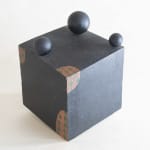







Taimei Morino (1934-Present)
Ceramic Cube (black and green), Circa 1970
Ceramic
9 3/4” x 7 1/4” x 7 1/4”
Further images
-
(View a larger image of thumbnail 1
)

-
(View a larger image of thumbnail 2
)

-
(View a larger image of thumbnail 3
)

-
(View a larger image of thumbnail 4
)

-
(View a larger image of thumbnail 5
)

-
(View a larger image of thumbnail 6
)

-
(View a larger image of thumbnail 7
)

-
(View a larger image of thumbnail 8
)

Born as the third generation to a family of potters, Hiroaki Morino Taimei (b. 1934) has had a long and instinctive involvement with clay. As a child, he likely wandered...
Born as the third generation to a family of potters, Hiroaki Morino Taimei (b. 1934) has had a long and instinctive involvement with clay. As a child, he likely wandered into his father’s studio only to be thrown a ball of clay to occupy his curious, active hands.
Morino went on to study ceramics at the Kyoto City University of Arts where he had the opportunity to study under Living National Treasures (ningen kokuhō) Tomimoto Kenkichi (1886-1963) and Fujimoto Yoshimichi “Nōdō” (1919-1992). Kenkichi once told Morino, jibun no mono o tsukure, which translates to “find your own way”. This left a strong impression on the artist, who found his voice seeking out igaisei, “unexpectedness”, in his works.
The ceramic “Box” is reflective of an artist who has found his way. His ability to embed feeling in his works comes largely from the fact that it is a medium he knows as well as his own body. It draws viewers in closer, not just visually but mentally to the artist. The work is light-hearted, bold, reserved, and elegant. A perfect piece for those who relish in the unexpected.
*(Morino baked the pieces in this series at a low temperature to achieve his desired effects. The pieces are prone to chip. There are a few small chips on the edge of this piece and it is priced accordingly.)
Morino went on to study ceramics at the Kyoto City University of Arts where he had the opportunity to study under Living National Treasures (ningen kokuhō) Tomimoto Kenkichi (1886-1963) and Fujimoto Yoshimichi “Nōdō” (1919-1992). Kenkichi once told Morino, jibun no mono o tsukure, which translates to “find your own way”. This left a strong impression on the artist, who found his voice seeking out igaisei, “unexpectedness”, in his works.
The ceramic “Box” is reflective of an artist who has found his way. His ability to embed feeling in his works comes largely from the fact that it is a medium he knows as well as his own body. It draws viewers in closer, not just visually but mentally to the artist. The work is light-hearted, bold, reserved, and elegant. A perfect piece for those who relish in the unexpected.
*(Morino baked the pieces in this series at a low temperature to achieve his desired effects. The pieces are prone to chip. There are a few small chips on the edge of this piece and it is priced accordingly.)
Signup for our Newsletter
You will receive two emails a month from us. One introduces artworks and design works from Kyoto's hidden sources and the other is stories from Misako, sharing insights into Japanese culture.
* denotes required fields
为了回应您的查询,我们将根据我们的隐私政策处理您提供的个人数据。